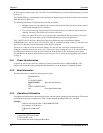
36 SUPERSTAR II User Manual Rev 3
Chapter 5 Message Formats
computed by the base station generating this Type 1 message. The message is of variable length, depending on
the number of satellites visible and pseudoranges corrected by the base station. Satellite specific data begins at
word 3 of the message.
Type 1 messages contain the following information for each satellite in view
at the base station:
• Satellite ID
• Pseudorange correction
• Range-rate correction
• Issue of Data (IOD)
When operating as a base station, the receiver’s position must be set using Message ID# 80, Set User’s
Position/Operating Mode. When operating as a rover station, the receiver COM port receiving the RTCM data
must be set to Rover mode using command Message ID# 80. Please refer to the L1 GPS Firmware Reference
Manual for more details on this input message.
5.1.2 RTCM2 Delta Differential GPS Corrections (Fixed)
Quite often a base station may have new ephemeris data before rover stations have collected the newer
ephemeris. The purpose of Type 2 messages is to act as a bridge between old and new ephemeris data. A base
station will transmit this Type 2 bridge data concurrently with Type 1's for a few minutes following receipt of a
new ephemeris. The rover station adds the Type 2 data (delta of old ephemeris minus new ephemeris) to the
Type 1 message data (new ephemeris) to calculate the correct pseudorange corrections (based on the old
ephemeris). Once the rover receiver has collected its own updated ephemeris, it will no longer utilize the Type
2 messages.
The GPS Card will accept and decode RTCM Standard Type 2 messages, when available and if required.
Type 2 messages are variable in length, depending on the number of satellites being tracked by the base station.
5.1.3 RTCM9 Partial Satellite Set Differential Corrections
RTCM Type 9 messages follow the same format as Type 1 messages. However, unlike a Type 1 message, Type
9 does not require a complete satellite set. This allows for much faster differential correction data updates to the
rover stations, thus improving performance and reducing latency.
Type 9 messages should give better performance with slow or noisy data links.
The base station transmitting the Type 9 corrections must be operating with a high-stability clock to
prevent degradation of navigation accuracy due to the unmodeled clock drift that can occur between Type
9 messages. For this reason, only receivers with an external oscillator can generate Type 9 messages.
SUPERSTAR II receivers can accept Type 9 messages.
NovAtel recommends a high-stability clock such as the PIEZO Model 2900082 whose 2-sample (Allan)
variance meets the following stability requirements:
3.24 x 10
-24
s
2
/s
2
between 0.5 - 2.0 seconds, and
1.69 x 10
-22
T s
2
/s
2
between 2.0 - 100.0 seconds
An external clock, such as an OCXO, requires approximately 10 minutes to warm up and become fully
stabilized after power is applied; do not broadcast RTCM Type 9 corrections during this warm-up period.


















